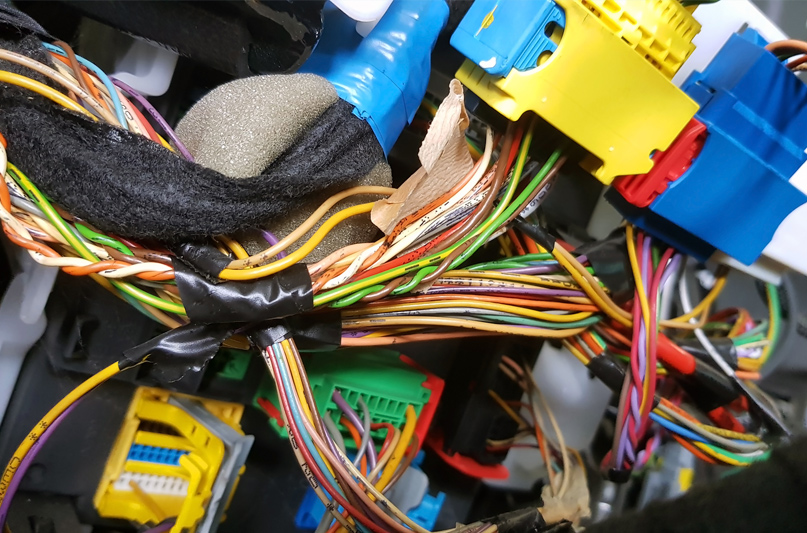
“Electricity is just organized lightning.”
– George Carlin
The electrical system aboard is a core part of the modern boat, much like the venous system of our own bodies. Without the electrical system operating properly, there are no multifunction displays or navigation lights, no TVs or refrigerators. Unless you are an ideologically motivated minimalist—commendable but the minority—the electricity must flow. In fact, those with modest needs, like Race to Alaska participants, are perhaps the biggest sticklers for every amp hour squeeze from their solar panels. They need to have a good working knowledge to avoid waste or error.
The sea requires some degree of self-reliance for those multiple days out. Owning and knowing the basics of how to use a multimeter, being familiar with the location, purpose, and basic details of the electrical system components aboard, and powering down the system before messing with the wires are important basics. Mastery of electricity makes civilized life possible, but it also can be lethal to the careless.
To beef up on our electrical systems knowledge, we talked to Jen Haaland, a senior marine electrician who works with Bellingham, Washington-based Northwest Explorations. Haaland has worked with the full-service charter, brokerage, and maintenance company for about six years and is a proud graduate of the Skagit Valley College’s Marine Technology Center.
NWY: What does a typical day look like as a senior electrical technician?
It varies a lot, that’s one of the aspects of this job that I like. Recently we’ve been doing a lot of inverter installations, general troubleshooting, a lithium ion battery bank conversion, and more.
NWY: What are some of the most common electrical systems problems aboard? How should boat owners manage them?
Power management is one of the most prevalent electrical issues I see on boats. Some boaters just haven’t been educated in this area. The heart of a vessel’s system is the battery bank(s). They power essential systems like navigation lights, engine starting, and your VHF radio. It’s so important to monitor and take care of your batteries.
Traditional lead-acid batteries found in most boats (wet cell, AGM, etc.) should not be discharged at more than 50 percent of their capacity, which is roughly 12.1 volts (or 24.2 volts for a 24v system). Once your batteries are down that low, it is crucial to recharge them using your battery charger or inverter/charger on shore power or through the generator, or with your engine’s alternator(s).
Depending on your battery bank size and size of your charger, it can take many hours to recharge your batteries to near full. Charging rates slow down as the battery gets full, so the last 10% can take up to 24 hours to recharge. A full battery is 12.7-12.8 volts at rest.
The key is “at rest.” There can be no charging sources or loads on your battery when you read the voltage. This is why we highly recommend a State of Charge (SOC) monitor that gives you a percentage of amp hours available in your bank. Properly installed, the SOC monitor will give an accurate picture of your battery bank that is simple to read just like a gas gauge.
NWY: You mentioned lithium ion batteries. Do you think they’ll be commonplace soon and help with power management?
ABYC (American Boat and Yacht Council) is still writing the standards for lithium-ion batteries. The batteries have some amazing benefits, like deeper discharge and faster recharge capabilities, but they also come with additional safety considerations so they should only be installed by trained electricians. Once ABYC publishes their standards, and once prices start coming down a little, I think they will become more commonplace, particularly on new boats.
Also related to electrical systems advancements, LED lights have done a lot to improve power consumption on vessels. I hope to see more advances like this. Digital switching with electronic displays that monitor everything, rather than breaker panels, will become more commonplace. Battery technologies will continue to improve. More and more wireless systems will be available.
NWY: Green sustainable energy is becoming more prevalent. How does wind, solar, and the like factor into one’s electrical?
Alternative energy sources like solar, wind, and fuel cells are a great supplemental charging option for boats that spend a long time away from the dock, particularly sailboats that don’t always have an engine running to recharge the batteries. Cost analysis for various systems varies, but solar can pay for itself in less than five years, even here in the often-cloudy Pacific Northwest. Charge rates are relatively low compared to AC chargers or high output alternators, so careful power management is necessary if they are your sole charging source.
NWY: When it comes to electrical systems, the trusty multimeter usually makes an appearance. Is it important to carry one aboard? Is so, what’s its use?
I highly recommend for every boat owner to have a quality digital multimeter, ideally with an AC/DC amp clamp. The new digital meters are much simpler to use and understand than the old analog meters. Most meters with an amp clamp are just AC, but the DC clamp is essential for boats. They cost a little more but are worth the expense.
I use a multimeter every day to troubleshoot electrical systems. You can check your battery voltage with the DC volt function, check to see if a fuse is blown with the continuity function, and check the output of your alternator with the DC amp clamp. For boaters new to using a multimeter, I would stick to testing DC systems only. For AC testing, I recommend a simple voltage detector pen that lights up and emits a tone when AC is present. It is a safe and easy way to see if you are getting AC power to your electrical panel or a device.
NWY: Do you have some useful troubleshooting tips to share if something isn’t working?
An electrical system is made up of just five components: source of power (ex: batteries, shore power, generator, inverter), a fuse, a switch, wiring from the source to the device and back to the source, and the device itself. Checking each component will find the culprit.
I like to start by looking at the source of power. For a DC component, what is your battery voltage? For an AC system,
use your voltage detector pen to see if the shore power cord is getting electricity.
Next, I check to see if this power is actually getting to the device by using my multimeter or voltage detector at the power wires on the device. If it is getting power and still not working, there is a problem with the device and it needs to be repaired or replaced. If it is not getting power, it’s time to look at the other components. Working backwards from the device, locate the switch and fuse or breaker. Test for voltage at each of these components to pinpoint the issue.
NWY: What are some things potential boat owners should look for when examining a boat for sale with regards to electrical system? What differentiates a good from bad wiring job?
Check for labeling. ABYC requires all wires to be labeled at both ends. An electrician who took the time to label their wires probably took the time to do the rest of the install correctly. Batteries should be labeled with their installation date (expect five-year lifespan, up to eight years if the batteries are not used much).
A properly labeled electrical system will save many hours when it comes time to troubleshoot. Wire runs should be tidy and secured every 18″. If the boat has a rat nest of unlabeled wires, or all black wires, expect to spend some extra money upgrading the system. A separate electrical survey, on top of your general survey, is a good idea.
NWY: What are some key points about inverters with regards to maintenance, longevity, etc.?
In the field, we typically see inverters last 10 to 15 years with no issues. Many boat owners are upgrading their old modified sine wave inverters to true sine wave inverters, which are essential for newer TVs and computers to run properly. Recommended maintenance is as simple as checking and tightening electrical connections once a year (be sure the system is completely powered down or hire an electrician to do this).
A properly installed inverter will be in a dry, cool, and well-ventilated space as close to the batteries as possible. It should have a Class-T fuse within 7″ of the battery (up to 72″ if the cable is sheathed). There should be a case ground cable the same size as, or one size smaller, than the main DC cables.
NWY: Do you have any thoughts with regards to the alternator’s role aboard?
Your engine’s alternator is a useful tool for recharging your batteries, but most stock alternators are pretty low amperage and will take a long time to recharge your batteries, especially at idle. I recommend upgrading your stock alternator to a high output, externally regulated alternator that will provide “smart” charging for your batteries.
On twin engine boats, or boats with heavy generator use, I often find one of the alternators is not even working but boat owners don’t notice because the batteries are staying charged through other sources. To test the output of your alternator, use the DC amp clamp setting on your multimeter, and clamp around the biggest red cable coming from your alternator. It’s important to only clamp one cable at a time or you will not get a good reading.
Run your engine and check your alternator amperage at idle. Increase your RPM and you should see the amperage rise. Put a large load on your batteries and see if your alternator keeps up with the demand.
NWY: Maintenance seems to be key. How do you keep track of what the Northwest Explorations fleet needs, and how can this be applied to boat owners?
At Northwest Explorations, we have a robust software system for tracking all repairs, upgrades, and required maintenance. There are apps and online software options for boat owners, but a simple spreadsheet works as well. Divide your vessels systems by type (electrical, plumbing, engines, etc.). Research and record each component on your boat and follow the manufacture’s recommend maintenance intervals. Most boat builders also publish maintenance recommendations for the vessel in the owner’s manual, which you can find online.
NWY: What are important points of maintenance to be aware of?
Check batteries to make sure they are staying charged on a daily or weekly basis. Monthly, check water levels in wet cell batteries. Also check shore power cord for corrosion and damage monthly as well. Test your batteries and check all electrical connections for corrosion and tightness (be sure all AC systems are powered off) annually. Make sure to pay careful attention to connections in wet spaces. Check bonding connections. Have generator load tested.
